JohnnyMac
Newly Enlightened
- Joined
- Mar 24, 2011
- Messages
- 181
ThruNite TN11S Cree XM-L U2 LED Flashlight with Extenders
* ThruNite TN11S provided for review courtesy of ThruNite.com

PROS
CONS
QUICK SUMMARY
Just doesn't warrant the price asked. Single cell performance is very poor and has noticeable PWM on Medium and High modes. Yes, PWM on high mode. Not unless you run the light on two 18650 cells does it run on high without PWM. Medium still has PWM. The dual switch tailcap is senseless and inconvenient. It would be far better to have the mode switch at the head of the light where it is useful in any situation. I generally really like ThruNite lights but I'd recommending passing on this one. You can stop reading here or you can continue on and see the details. It's not for me but it might be a good light to you. Read on to find out if you are still interested.
Specifications from ThruNite's site:
· LED: Cree XML U2 LED with a lifespan of 20+years of run time.
· Max 830 lumen output using 3 or 4*CR123A or 2*18650 batteries (with extended tubes).
· Low: 9.4 lm. 130 hours; Mid: 424.7 lm. 3 hours; High: 830lm. 80 minutes; Strobe: 830lm. 2.7 hours.
· Working voltage: 3V to 12V.
· Removable steel pocket clip.
· Max runtime: 130 hours.
· Max beam distance: 355 meters.
· Peak beam intensity: 28900cd.
· Impact resistant: 1.2 meters.
· Waterproof to IPX-8 standard.
· 157.50mm length, 41.00mm bezel diameter. (without extended tube)
· Weight: 169.20g without battery.
· Aircraft grade aluminum body structure.
· Premium type III hard anodized anti-abrasive finish
· Ultra-clear tempered glass lens with anti-reflective coating.
· Momentary forward click tactical switch.
· Programmable memory function.
· Strobe mode for tactical and emergency use.
· Low, medium and high modes to balance power consumption and light output.
· Stainless steel front striking bezel.
· Smooth reflector for max light output.
· Highly focused beam for maximum distance.
· Tactical knurling for firm grip.
· Streamlined body design.
· Reversed polarity protection.
· Durable T-shaped thread.
· Side switch on tail cap for direct access to strobe from power-off and changing modes form power-on for Military and Tactical Application.
· Retail price: Normally $99.00 but currently reduced to $89.95
Operation:
· To power on / off the light:
Press the tail cap half way to momentarily activate the light, completely press the tail cap to click,
the light will stay on. Push the tail cap again to click, the light will go off.
· Mode Switch:
Clicking the side switch when power-on cycles modes through low, medium, high, and strobe.
· Direct Strobe Access:
Pressing the side switch when power-off activates strobe mode directly.
· Battery Replacement:
Take off the tail cap, insert the battery with positive toward the LED assembly (head of the light),
install the tail cap and tighten all the way to operate the light.
DIMENSIONS
Head diameter: 41mm
Tail diameter: 28mm
Body diameter: 25.4
Body length (1 cell): 158mm
Lens diameter* thickness: 37.5mm*2mm
Reflector O.D.: 34.6mm
Reflector I.D.: 31.5mm
Reflector depth: 32.2mm
Emitter MCPCB: 16mm
PERFORMANCE
Output:
OTF Output levels measured on my Integrating Sphere. Lux and throw measured at 2 meters and converted back to 1 meter. Testing performed with Panasonic NCR18650PD cells
As you can see, the output is not regulated. To get the full output of the light you must be running at least 8.4v but ThruNite's rated specs are pretty close to what I got during my testing.
Aside from the very poor output on a single 18650 cell, PWM was a factor that just shouldn't exist on a light with this asking price and reputation. Oddly enough, only on Low mode was PWN not an issue when running the TN11S on a single cell. PWM on Medium and High is simply inexcusable. You did read that right - PWM on High when running a single cell. When running two cells PWM is really only noticeable in Medium mode and not at all in High mode.
Interface:
The TN11S has an unusual switch arrangement. The main switch is located at the very rear of the tail cap and is a mechanical forward clicky. Mode selection is done with a secondary electronic switch located on the side of the tailcap literally just around the corner of the primary switch. I feel this design is a fail and is pretty senseless. In order to use the light in a tactical hold your thumb is already right at the tail switch. Why have mode selection there as well when the main switch is 1/2" away anyway? The secondary mode switch would have been much better had it been by the head of the light where it could be used to change modes in a regular hand hold as well. The boot on the secondary switch is small and smooth and very hard to find by feel.
The light has last mode memory and the momentary on function works in whatever mode the light was last in. Modes selection is Low/Medium/High/Strobe. The strobe is not a random strobe but it is a two stage strobe where it will flash a fast strobe for 2 seconds then a slow strobe for 2 seconds then repeats this sequence until taken out of strobe mode. Strobe can be access with the light off by pressing and holding the secondary side switch.
For mode selection I have only a couple issues. The first is the mode spacing itself. Not really that much difference between low and medium modes but that is a matter of personal taste. My second issue with the interface is a more serious issue for me and it is that strobe mode is not a hidden mode. In order to get from medium or high mode back to low or medium modes you must cycle through strobe mode. On a budget Ultrafire light that might be tolerable but on a light that costs $90.
While the light has a mechanical switch and electronic secondary switch you would think that the primary switch could lock out the power and prevent parasitic drain. I'm not sure if it does and here is why: With the mechanical primary switch is in the off position, pressing the secondary switch engages the strobe mode. This is a great feature if the light is off and you need quick access to a tactical type strobe. It means that the electronic switch must have access to power even with the primary switch in the off position. If you hold down the secondary switch for strobe until it goes through one full cycle of fast then slow strobe the light will stay in strobe mode even if you release the secondary switch. A second click of the side switch turns off the strobe. Obviously there is some electronic trickery going on where the momentary electrical side switch gets power even with the main switch off.
In single 18650 cell mode the battery tube threads are anodized where it threads into the tail cap. When it doubt or if packing the light in your carry bag you can always lockout all switches by unscrewing the tailcap a quarter turn. When using one or both extension tubes the tailcap cannot be locket out because the threads on both ends of the extension tubes are unanodized.
CONSTRUCTION
I will discuss the build quality and features as we go through each picture. As always, clicking a picture opens the full version in a new tab/window.
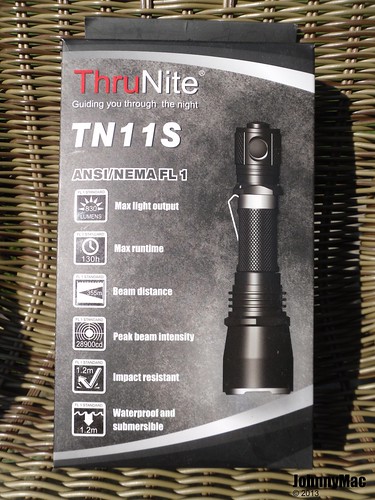
Packaging is clean, simple and attractive.

Inside the box you will find the light along with the holster, extension tubes, and accessories.

With everything removed from the inner plastic container we find the following:

Very nice reflector and a mildly crenelated bezel.

Single 18650/2*CR123A form.


Here is the TN11S in 3*CR123A form with one extension tube attached.

Here is the TN11S in 2*18650/4*CR123A format with both extension tubes attached.

Very nice machining on the body. All edges are soft with no sharp edges. Anodizing is consistent and very durable.

The laser etching is very poor. Not only are the edges blurry and fuzzy, the smaller etching looks like it was done in draft mode. It is very bandy and looks pretty bad. Not something you expect in a $90 light. I've not seen it in a $10 light before.
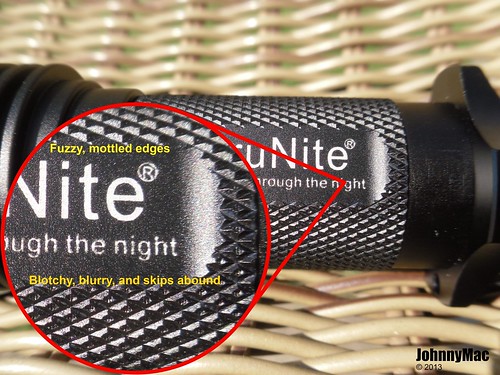
The knurling is fantastic. Cleanly cut but very deep and grippy.

The two switches in the tail cap. The primary has very good feel and is easy to work even with heavily gloved hands. The secondary switch has a small button and is very smooth but fairly stiff. It would be very difficult to locate and work with heavily gloved hands.


Square cut and nicely machined threads connect the head and main battery tube. Very thick and tight O-ring for a good seal.

Tail threads on the primary battery tube are clean, square, and anodized. The O-ring is very thick and provides great seal.

The included CR123A spacer tube fits inside the primary tube and keeps the cells from rattling when using two CR123A cells. The problem arises when using 3 or 4 CR123A cells. The extension tubes accommodate them but there is no sleeve for these extra cell formats. Those extra cells will rattle and be loose.

The TN11S will accommodate and 18650 cells, protected or unprotected. Flat top cells can be used safely in single cell format but you will need button topped cells if using more than one.

The tactical ring provides the anti-roll function and is removable. In order to remove or install it you must first remove the O-ring as it will not fit over the O-ring.
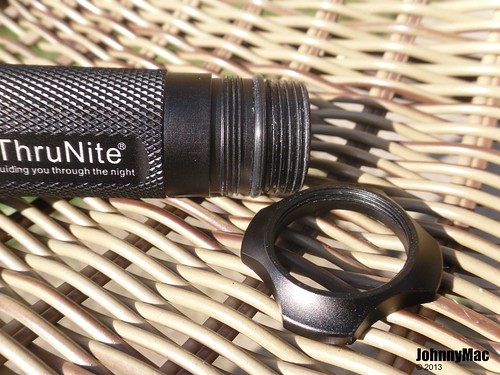
You won't want to use the light without the tactical ring. It leaves all the threads exposed and doesn't look good.

The pocket clip is absolutely lovely. It is thick, durable, smooth and polished to a beautiful luster. Almost looks like a fine piece of silver jewelry.

The pocket clip fits perfectly over the smooth area just behind the knurling. To install it you have to remove the rear O-ring and tactical ring. With those off it can slide on from the rear. It is too stiff and the opening too small to be pressed onto the light form the side. How do I know this? I tried. I am pleased to say that the anodization is very durable as nothing was damaged or scratched in the attempt.

A stiff spring provides positive battery connection to the driver and allows the use of flat-topped cells

Not sure you can see it from here but the O-ring behind the lens is pretty much useless. It is wider in diameter than the reflector, which is mistake number one. The second problem is the reflector leaves a gap around it's outside and the inside of the head where it sits. The O-ring, when the lens and bezel are installed, is pushed behind into the gap between the reflector and head rendering it pretty useless.

Here you can see how the O-ring is larger than the reflector and very thin, allowing it to slip behind the reflector.

With the reflector removed you can see the emitter and the centering insulator.

The pill unscrews from the front and has the same, well machined square threading as the rest of the light.

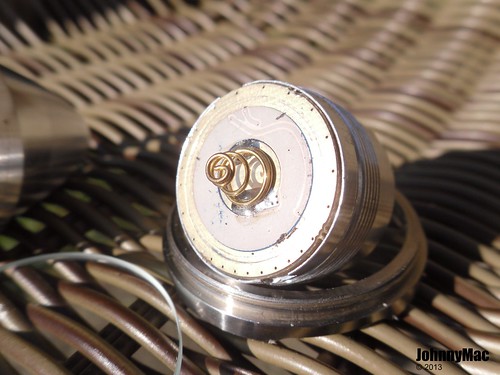

Popping off the centering insulator reveals a 1st generation XM-L U2 emitter mounted to a solid copper MCPCB with direct thermal path. Thermal grease is between the MCPCB and the pill. A new, updated model like this should really have an XM-L2 emitter in it, especially at this price point.

A nice looking driver sits inside the pill. Wires from the driver to the emitter are pretty thick gauge.

The inside of the pill is deep and could accommodate a thicker driver if one were to switch it out.

A look into the head from the back with the pill removed.

Moving onto the tailcap we find what appears on the outside to be your normal fare.

Unscrewing the retaining ring shows a nicely threaded retaining ring with a very heavy O-ring used to insulate the spring from the body of the tailcap.

So far the switch assembly only looks a little different than expected.

The switch assembly slides out and reveals the side switch boot (combination of switch boot and grommet). A white nylon disk sits between the switch assembly and the primary tail switch boot.

Innards removed, you can see how the tail switch assembly almost looks like a second driver in and of itself.

The momentary on tactile electronic switch mounts on the side between the two switch PCBs.

Both switch boots. you can see how the smaller side boot is contoured to fit the side of the tailcap and fits in it like a grommet.

Tailcap with components removed.

Here is the TN11S with all extension tubes attached and inside it's very nice holster. The holster itself is very well made.

Here you can see the modes of the light in action.

The spill on the TN11S is very smooth with a concentrated hotspot. Hard to see well in this photo but there is not much corona around the hotspot and it is extremely well defined. Spill is also a bit sider than it appears i this pic.

Here you can see the beam angles in each of the 3 main modes. The SMO reflector does a very good job of producing lots of throw in a smaller headed tactical light.



I created an animated gif to show the output in each mode outdoors. The pictures were taken at about 25yds from the house.
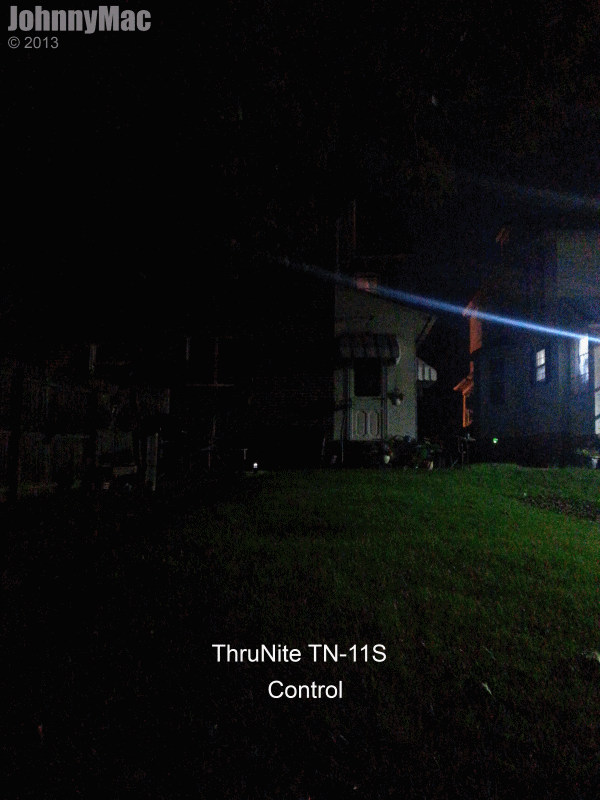
Comparing the TN11S with some competing brands and models. Reflector diameter is about the same as the Armytek Viking. From left to right these lights are:
Solarforce L2T - Armytek Viking 2.5 - Crelant 7G2CS - ThruNite TN11S

Lengthwise the TN11S is the longest of the bunch.

I hope you enjoyed this review. Feel free to ask questions and offer comments and thoughts.
~ Johnny
* ThruNite TN11S provided for review courtesy of ThruNite.com

PROS
- Runs on 1 or 2 18650 cells and on 2/3/4 CR123 primaries
- Very good machining.
- Very grippy knurling.
- AR coated lens.
- Good brightness with 2*18650 cells
- Clean, very focused how spot.
- PWM on lowest mode is very high and barely detectable.
- Heavy O-rings and tight seal throughout all threaded connections.
- I really dig the quality of the pocket clip.
CONS
- Strobe not hidden and must be cycled through to get back to other modes.
- Driver is not regulated.
- PWM on medium is very noticeable.
- PWM on high mode too? Yes, when using a single cell, and noticeable PWM, too.
- Don't care for the secondary mode switch on the tail.
- Output on single 18650 cell is half of what it is on high.
- Designed for 2/3/4 CR123 cells but battery sleeve for these cells covers only 2 cells.
- Only the main tube has anodized threads. Extension tubes are unanodized and tail cannot be locked out.
- Wouldn't trust waterproofing in anything more than rain due to poor lens gasket design.
- Poor laser etching on logos
QUICK SUMMARY
Just doesn't warrant the price asked. Single cell performance is very poor and has noticeable PWM on Medium and High modes. Yes, PWM on high mode. Not unless you run the light on two 18650 cells does it run on high without PWM. Medium still has PWM. The dual switch tailcap is senseless and inconvenient. It would be far better to have the mode switch at the head of the light where it is useful in any situation. I generally really like ThruNite lights but I'd recommending passing on this one. You can stop reading here or you can continue on and see the details. It's not for me but it might be a good light to you. Read on to find out if you are still interested.
Specifications from ThruNite's site:
· LED: Cree XML U2 LED with a lifespan of 20+years of run time.
· Max 830 lumen output using 3 or 4*CR123A or 2*18650 batteries (with extended tubes).
· Low: 9.4 lm. 130 hours; Mid: 424.7 lm. 3 hours; High: 830lm. 80 minutes; Strobe: 830lm. 2.7 hours.
· Working voltage: 3V to 12V.
· Removable steel pocket clip.
· Max runtime: 130 hours.
· Max beam distance: 355 meters.
· Peak beam intensity: 28900cd.
· Impact resistant: 1.2 meters.
· Waterproof to IPX-8 standard.
· 157.50mm length, 41.00mm bezel diameter. (without extended tube)
· Weight: 169.20g without battery.
· Aircraft grade aluminum body structure.
· Premium type III hard anodized anti-abrasive finish
· Ultra-clear tempered glass lens with anti-reflective coating.
· Momentary forward click tactical switch.
· Programmable memory function.
· Strobe mode for tactical and emergency use.
· Low, medium and high modes to balance power consumption and light output.
· Stainless steel front striking bezel.
· Smooth reflector for max light output.
· Highly focused beam for maximum distance.
· Tactical knurling for firm grip.
· Streamlined body design.
· Reversed polarity protection.
· Durable T-shaped thread.
· Side switch on tail cap for direct access to strobe from power-off and changing modes form power-on for Military and Tactical Application.
· Retail price: Normally $99.00 but currently reduced to $89.95
Operation:
· To power on / off the light:
Press the tail cap half way to momentarily activate the light, completely press the tail cap to click,
the light will stay on. Push the tail cap again to click, the light will go off.
· Mode Switch:
Clicking the side switch when power-on cycles modes through low, medium, high, and strobe.
· Direct Strobe Access:
Pressing the side switch when power-off activates strobe mode directly.
· Battery Replacement:
Take off the tail cap, insert the battery with positive toward the LED assembly (head of the light),
install the tail cap and tighten all the way to operate the light.
DIMENSIONS
Head diameter: 41mm
Tail diameter: 28mm
Body diameter: 25.4
Body length (1 cell): 158mm
Lens diameter* thickness: 37.5mm*2mm
Reflector O.D.: 34.6mm
Reflector I.D.: 31.5mm
Reflector depth: 32.2mm
Emitter MCPCB: 16mm
PERFORMANCE
Output:
OTF Output levels measured on my Integrating Sphere. Lux and throw measured at 2 meters and converted back to 1 meter. Testing performed with Panasonic NCR18650PD cells
| Mode | Output on 1*18650 | Output on 2*18650 |
| Low | 12.47 | 11 |
| Medium | 54.8 | 95.7 |
| High | 477.6 | 873.1 |
| Number of Cells | Lux @ 2m | Lux @ 1m | Throw to .25 lux |
| 1 * 18650 | 4000 | 15,999.7 | 252.98m |
| 2 * 18650 | 6840 | 27,357.16 | 330.8m |
As you can see, the output is not regulated. To get the full output of the light you must be running at least 8.4v but ThruNite's rated specs are pretty close to what I got during my testing.
Aside from the very poor output on a single 18650 cell, PWM was a factor that just shouldn't exist on a light with this asking price and reputation. Oddly enough, only on Low mode was PWN not an issue when running the TN11S on a single cell. PWM on Medium and High is simply inexcusable. You did read that right - PWM on High when running a single cell. When running two cells PWM is really only noticeable in Medium mode and not at all in High mode.
Interface:
The TN11S has an unusual switch arrangement. The main switch is located at the very rear of the tail cap and is a mechanical forward clicky. Mode selection is done with a secondary electronic switch located on the side of the tailcap literally just around the corner of the primary switch. I feel this design is a fail and is pretty senseless. In order to use the light in a tactical hold your thumb is already right at the tail switch. Why have mode selection there as well when the main switch is 1/2" away anyway? The secondary mode switch would have been much better had it been by the head of the light where it could be used to change modes in a regular hand hold as well. The boot on the secondary switch is small and smooth and very hard to find by feel.
The light has last mode memory and the momentary on function works in whatever mode the light was last in. Modes selection is Low/Medium/High/Strobe. The strobe is not a random strobe but it is a two stage strobe where it will flash a fast strobe for 2 seconds then a slow strobe for 2 seconds then repeats this sequence until taken out of strobe mode. Strobe can be access with the light off by pressing and holding the secondary side switch.
For mode selection I have only a couple issues. The first is the mode spacing itself. Not really that much difference between low and medium modes but that is a matter of personal taste. My second issue with the interface is a more serious issue for me and it is that strobe mode is not a hidden mode. In order to get from medium or high mode back to low or medium modes you must cycle through strobe mode. On a budget Ultrafire light that might be tolerable but on a light that costs $90.
While the light has a mechanical switch and electronic secondary switch you would think that the primary switch could lock out the power and prevent parasitic drain. I'm not sure if it does and here is why: With the mechanical primary switch is in the off position, pressing the secondary switch engages the strobe mode. This is a great feature if the light is off and you need quick access to a tactical type strobe. It means that the electronic switch must have access to power even with the primary switch in the off position. If you hold down the secondary switch for strobe until it goes through one full cycle of fast then slow strobe the light will stay in strobe mode even if you release the secondary switch. A second click of the side switch turns off the strobe. Obviously there is some electronic trickery going on where the momentary electrical side switch gets power even with the main switch off.
In single 18650 cell mode the battery tube threads are anodized where it threads into the tail cap. When it doubt or if packing the light in your carry bag you can always lockout all switches by unscrewing the tailcap a quarter turn. When using one or both extension tubes the tailcap cannot be locket out because the threads on both ends of the extension tubes are unanodized.
CONSTRUCTION
I will discuss the build quality and features as we go through each picture. As always, clicking a picture opens the full version in a new tab/window.

Packaging is clean, simple and attractive.

Inside the box you will find the light along with the holster, extension tubes, and accessories.

With everything removed from the inner plastic container we find the following:
- Main TN11S flashlight
- CR123A spacer tube (stored inside the main battery tube from the factory) to prevent battery rattle using two CR123A cells
- Two extension tubes.
- Spare O-rings
- Very nice lanyard with Lobster claw
- Pocket/belt clip
- Holster

Very nice reflector and a mildly crenelated bezel.

Single 18650/2*CR123A form.


Here is the TN11S in 3*CR123A form with one extension tube attached.

Here is the TN11S in 2*18650/4*CR123A format with both extension tubes attached.

Very nice machining on the body. All edges are soft with no sharp edges. Anodizing is consistent and very durable.

The laser etching is very poor. Not only are the edges blurry and fuzzy, the smaller etching looks like it was done in draft mode. It is very bandy and looks pretty bad. Not something you expect in a $90 light. I've not seen it in a $10 light before.

The knurling is fantastic. Cleanly cut but very deep and grippy.

The two switches in the tail cap. The primary has very good feel and is easy to work even with heavily gloved hands. The secondary switch has a small button and is very smooth but fairly stiff. It would be very difficult to locate and work with heavily gloved hands.


Square cut and nicely machined threads connect the head and main battery tube. Very thick and tight O-ring for a good seal.

Tail threads on the primary battery tube are clean, square, and anodized. The O-ring is very thick and provides great seal.

The included CR123A spacer tube fits inside the primary tube and keeps the cells from rattling when using two CR123A cells. The problem arises when using 3 or 4 CR123A cells. The extension tubes accommodate them but there is no sleeve for these extra cell formats. Those extra cells will rattle and be loose.

The TN11S will accommodate and 18650 cells, protected or unprotected. Flat top cells can be used safely in single cell format but you will need button topped cells if using more than one.

The tactical ring provides the anti-roll function and is removable. In order to remove or install it you must first remove the O-ring as it will not fit over the O-ring.

You won't want to use the light without the tactical ring. It leaves all the threads exposed and doesn't look good.

The pocket clip is absolutely lovely. It is thick, durable, smooth and polished to a beautiful luster. Almost looks like a fine piece of silver jewelry.

The pocket clip fits perfectly over the smooth area just behind the knurling. To install it you have to remove the rear O-ring and tactical ring. With those off it can slide on from the rear. It is too stiff and the opening too small to be pressed onto the light form the side. How do I know this? I tried. I am pleased to say that the anodization is very durable as nothing was damaged or scratched in the attempt.

A stiff spring provides positive battery connection to the driver and allows the use of flat-topped cells

Not sure you can see it from here but the O-ring behind the lens is pretty much useless. It is wider in diameter than the reflector, which is mistake number one. The second problem is the reflector leaves a gap around it's outside and the inside of the head where it sits. The O-ring, when the lens and bezel are installed, is pushed behind into the gap between the reflector and head rendering it pretty useless.

Here you can see how the O-ring is larger than the reflector and very thin, allowing it to slip behind the reflector.

With the reflector removed you can see the emitter and the centering insulator.

The pill unscrews from the front and has the same, well machined square threading as the rest of the light.



Popping off the centering insulator reveals a 1st generation XM-L U2 emitter mounted to a solid copper MCPCB with direct thermal path. Thermal grease is between the MCPCB and the pill. A new, updated model like this should really have an XM-L2 emitter in it, especially at this price point.

A nice looking driver sits inside the pill. Wires from the driver to the emitter are pretty thick gauge.

The inside of the pill is deep and could accommodate a thicker driver if one were to switch it out.

A look into the head from the back with the pill removed.

Moving onto the tailcap we find what appears on the outside to be your normal fare.

Unscrewing the retaining ring shows a nicely threaded retaining ring with a very heavy O-ring used to insulate the spring from the body of the tailcap.

So far the switch assembly only looks a little different than expected.

The switch assembly slides out and reveals the side switch boot (combination of switch boot and grommet). A white nylon disk sits between the switch assembly and the primary tail switch boot.

Innards removed, you can see how the tail switch assembly almost looks like a second driver in and of itself.

The momentary on tactile electronic switch mounts on the side between the two switch PCBs.

Both switch boots. you can see how the smaller side boot is contoured to fit the side of the tailcap and fits in it like a grommet.

Tailcap with components removed.

Here is the TN11S with all extension tubes attached and inside it's very nice holster. The holster itself is very well made.

Here you can see the modes of the light in action.

The spill on the TN11S is very smooth with a concentrated hotspot. Hard to see well in this photo but there is not much corona around the hotspot and it is extremely well defined. Spill is also a bit sider than it appears i this pic.

Here you can see the beam angles in each of the 3 main modes. The SMO reflector does a very good job of producing lots of throw in a smaller headed tactical light.



I created an animated gif to show the output in each mode outdoors. The pictures were taken at about 25yds from the house.

Comparing the TN11S with some competing brands and models. Reflector diameter is about the same as the Armytek Viking. From left to right these lights are:
Solarforce L2T - Armytek Viking 2.5 - Crelant 7G2CS - ThruNite TN11S

Lengthwise the TN11S is the longest of the bunch.

I hope you enjoyed this review. Feel free to ask questions and offer comments and thoughts.
~ Johnny

